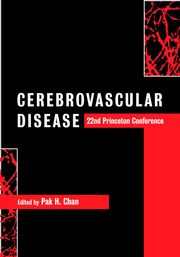Book contents
- Frontmatter
- Contents
- List of contributors
- Preface
- Acknowledgments
- Part I Special lectures
- Part II Oxidative stress
- Part III Apoptosis
- Part IV Hot topics
- Part V Hemorrhage, edema and secondary injury
- Part VI Inflammation
- Part VII Gene transfer and therapy
- Part VIII Neurogenesis and plasticity
- Part IX Magnetic resonance imaging in clinical stroke
- 28 Magnetic resonance imaging in stroke trials
- 29 Disappearing deficits and disappearing lesions: diffusion/perfusion MRI in transient ischemic attack and intra-arterial thrombolysis
- 30 Diffusion and perfusion magnetic resonance imaging in the evaluation of acute ischemic stroke
- 31 Early recanalization in acute ischemic stroke saves tissue at risk defined by stroke magnetic resonance imaging
- Part X Risk factors, clinical trials and new therapeutic horizons
- Index
- Plate section
29 - Disappearing deficits and disappearing lesions: diffusion/perfusion MRI in transient ischemic attack and intra-arterial thrombolysis
from Part IX - Magnetic resonance imaging in clinical stroke
Published online by Cambridge University Press: 02 November 2009
- Frontmatter
- Contents
- List of contributors
- Preface
- Acknowledgments
- Part I Special lectures
- Part II Oxidative stress
- Part III Apoptosis
- Part IV Hot topics
- Part V Hemorrhage, edema and secondary injury
- Part VI Inflammation
- Part VII Gene transfer and therapy
- Part VIII Neurogenesis and plasticity
- Part IX Magnetic resonance imaging in clinical stroke
- 28 Magnetic resonance imaging in stroke trials
- 29 Disappearing deficits and disappearing lesions: diffusion/perfusion MRI in transient ischemic attack and intra-arterial thrombolysis
- 30 Diffusion and perfusion magnetic resonance imaging in the evaluation of acute ischemic stroke
- 31 Early recanalization in acute ischemic stroke saves tissue at risk defined by stroke magnetic resonance imaging
- Part X Risk factors, clinical trials and new therapeutic horizons
- Index
- Plate section
Summary
Introduction
The brain responds dynamically to ischemic insult. A brief period of focal ischemia may disrupt synaptic transmission and produce transient neurological deficits without causing permanent tissue injury. A somewhat more severe ischemic insult may sufficiently disrupt the cellular energetic state to impair maintenance of ionic gradients across cell membranes, producing cytotoxic edema. Early restoration of blood flow may permit cellular re-energization and restoration of ionic gradients, with edema resolution. However, some cells that initially restore membrane integrity experience a late, secondary stage of injury and delayed cell death. These findings, previously elucidated in animal models, have now been demonstrated for the first time in acute human brain ischemia by diffusion magnetic resonance imaging (MRI).
Standard brain imaging techniques, computed tomography (CT) and conventional MRI, are insensitive to these dynamic and regionally varying neural parenchymal responses to tissue ischemia. In contrast, the novel MRI technique of diffusion imaging permits visualization of these critical tissue processes, affording new insights into the physiopathology of human cerebral ischemia. We will here review recent diffusion MRI findings in two settings of transient cerebral ischemic insult in human patients: spontaneous transient ischemic attacks and thrombolysis induced cerebral reperfusion.
Transient ischemic attack
Transient ischemic attacks (TIAs) are defined as neurological symptoms due to focal cerebral ischemia that resolve completely within 24 hours. The 24 hour cutoff employed in this definition was first promulgated in the 1950s, based on limited data.
- Type
- Chapter
- Information
- Cerebrovascular Disease22nd Princeton Conference, pp. 353 - 370Publisher: Cambridge University PressPrint publication year: 2002



